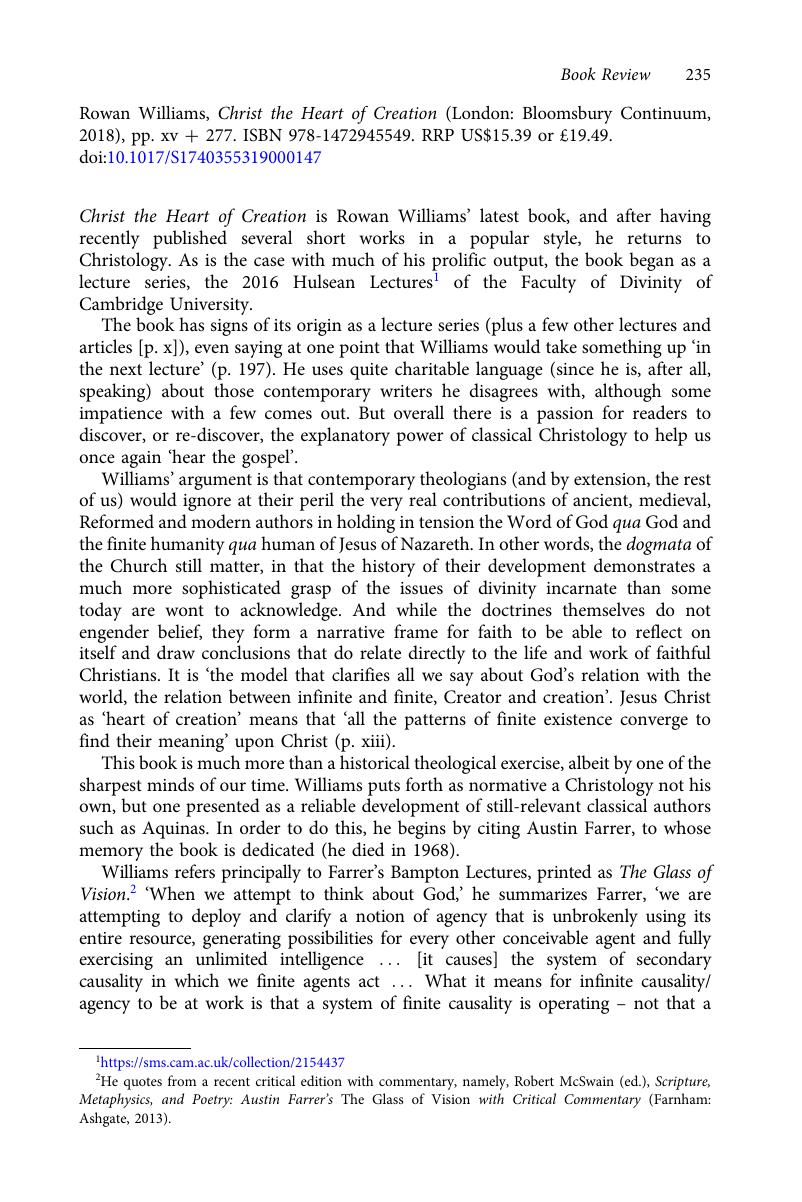No CrossRef data available.
Article contents
Rowan Williams, Christ the Heart of Creation (London: Bloomsbury Continuum, 2018), pp. xv + 277. ISBN 978-1472945549. RRP US$15.39 or £19.49.
Published online by Cambridge University Press: 18 July 2019
Abstract

- Type
- Book Review
- Information
- Copyright
- © The Journal of Anglican Studies Trust 2019
References
2 He quotes from a recent critical edition with commentary, namely, Robert McSwain (ed.), Scripture, Metaphysics, and Poetry: Austin Farrer’s The Glass of Vision with Critical Commentary (Farnham: Ashgate, 2013).
3 The Glass of Vision in McSwain, Scripture, p. 35; quoted in Williams, Christ the Heart of Creation, p. 4. ‘…in the second cause the first cause operates’, completing Farrer’s sentence that Williams quoted.
4 Farrer, Glass, p. 36; Williams, Christ the Heart of Creation, p. 5.
5 Found in Interpretation and Belief (ed. Charles Conti; London: SPCK, 1976), pp. 126-37. To sum up his conclusions: (1) the God-Man is not a combination of divine and human, but the act of God ‘finitizing’ (his word) the divine personal action. So, Jesus is ‘purely divine in being purely human’). And specifically, it is (2) the Second Person of the Trinity, the Word or Son, who is incarnate, so that we become God’s adopted children ‘by association. The sonship is spread to embrace us.’ And so (3), the incarnation creates a real historical human being in the same limits of circumstances and knowledge as yours or mine. Yet Jesus ‘knew how to play his divine part rather than knowing that his part was, in a metaphysical sense, divine.’ Which leads to his compassion for us (p. 137; emphases mine).
6 Williams, Christ the Heart of Creation, p. 7, n. 12, referencing Hick’s essay ‘Jesus and the World’s Religions’ in The Myth of God Incarnate (London: SCM Press, 1977), pp. 167-85.
7 See Richard Cross, The Metaphysics of the Incarnation: From Thomas Aquinas to Duns Scotus (Oxford: Oxford University Press, 2002).
8 The term homoousios occurs only once, as does the term homoousion.
9 By this I mean a move similar to the effect of Article 6 of the Thirty-nine Articles of Religion, declaring that the ‘Holy Scriptures contain all things necessary to salvation’, without spelling out what those ‘things’ are per se.
10 It is worth noting that ‘haecceity’ remains an important concept down to our day, embraced by some philosophers over against Thomist quiddity. This fact underlines the enduring power of both men’s thought – Duns Scotus is not called ‘The Subtle Doctor’ without reason.
11 The full discussion of John Calvin’s Christology is found on pp. 141-67.
12 Williams’ far-ranging analysis of Bonhoeffer is found on pp. 183-217.
13 Erich Przywara, Analogia Entis: Metaphysics: Original Structure and Universal Rhythm (trans. John Betz and David Bentley Hart; Grand Rapids, MI: Eerdmans, 2014), pp. 531-32.
14 The Edge of Words: God and the Habits of Language by Rowan Williams (London: Bloomsbury, 2014). See my review, in the Sewanee Theology Review, 57.4 (2016).
15 The subject of a recent critically acclaimed opera in Geneva, Switzerland, by a local composer, Shauna Beesley, and Jean-Claude Humbert, librettist, entitled ‘Le Procès de Michel Servet’.
16 Like Williams, Lonergan’s intent is to repristinate classical Christology and its development for his own generation. And similarly, both have been labeled conservatives, which might fit if developing startling new perspectives from a careful study of what has been handed down is actually what that means. See Bernard Lonergan, The Way to Nicea: The Dialectical Development of Trinitarian Theology (trans. Conn O’Donovan; London: Darton, Longman & Todd, 1976). A newer version is the complete bilingual translation of De Deo trino, the original Latin document of which The Way to Nicea is the Prolegomenon. See Bernard Lonergan, The Triune God: XI. Doctrines, and XII. Systematics (trans. Michael G. Shields; ed. Robert M. Doran and H. Daniel Monsour; Toronto: University of Toronto Press, 2009). According to his first translator, Lonergan was unenthusiastic about translating his treatise. He had been obligated as professor in Rome to write in Latin, and he remarked once that ‘Latin is fine, if you have nothing to say that Marcus Tullius Cicero could not have said’.


